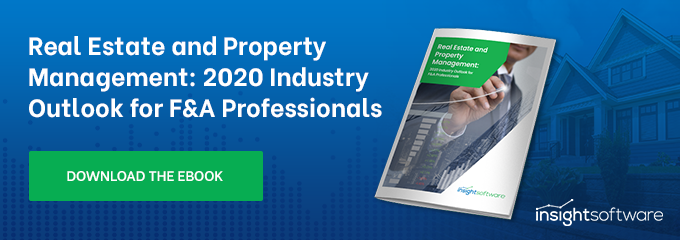Agile Financial Reporting for Real Estate: A Quick Guide to Reshaping Future Growth

2020 has brought on a myriad of challenges for businesses across every industry, and real estate is no exception. Demand has shifted dramatically, sometimes upward and sometimes down. For certain industries, sales are booming. For others, the disruption has resulted in a slowdown that could last for years. In every case, though, agility is a recurring theme. Businesses that build competency for agility will be the winners in the coming decade.
Practically speaking, competency for agility means the ability to collect information in real time, to analyze it quickly and accurately, and to respond rapidly to changing conditions. Agility also calls for automation, smart deployment of digital transformation technologies, and a willingness to explore new business models and innovations.
There is a temptation to think of real estate as a slow mover because it is capital-intensive and because liquidity is limited. To some extent, that is true. At the same time, however, new business models are emerging. Technology is being deployed in innovative new ways, and a shifting landscape calls for business leaders to address new problems with new approaches.
Exploring Market Trends
For commercial real estate, the shift to remote work is significant and is likely to have long-lasting effects as employers have developed remote work capabilities and employees have realized the benefits of working from home. The fallout from COVID-related shutdowns is less certain. Small business bankruptcies are up, especially among restaurants and bars. There is uncertainty, too, around the business climate in many urban areas of the US in the wake of the damage done by rioters and looters.
Residential landlords have been negatively impacted by government orders giving tenants greater flexibility in rent payments. Tightening economic conditions, likewise, could result in higher vacancy rates for residential units.
Not all of the trends are downward, though. Residential real estate in less populated areas is booming. The self-storage industry, likewise, has seen an increase in business, as many college students have returned home and numerous professionals have reorganized their households to make space for home offices.
Creative construction is at work in other ways as well. As online commerce booms, Amazon has set up distribution centers in formerly unused or underutilized space. Amazon’s recent discussions with the Simon Property Group to set up fulfillment centers in shopping malls has received a good deal of press coverage.
Finally, there is the question of capital. The credit market has tightened, making it more difficult to secure loans. At the same time, low interest rates continue to drive investors to options that provide better returns, including real estate investment trusts (REITs)
Given all of these trends, how can real estate professionals better position their organizations for growth? Agility is a key mandate for doing business in the 2020s.
What does agility look like for real estate? It starts with automation.
Agility through Automation
On one level, automation is about efficiency. By removing human effort from a process, it can be performed with a smaller expenditure of resources. In the context of agility, though, automation plays an even more important role; it is also about speed of execution.
Consider one of the more tedious and time-consuming tasks that consume resources in the Finance department: The process of extracting data from one or more sources, copying and pasting that information into Excel spreadsheets, performing some analysis on those data, and delivering a recommendation or insight to business leaders.
It is sometimes hard to imagine that in an era in which so many systems and processes are automated, most businesses are still performing this particular process manually. The extract/copy/paste process is tedious, consuming valuable staff time that could be put to much better use. It is also highly prone to errors; by transposing a number, omitting a cell, or pasting data into the wrong location, the end result of all that effort may be rendered entirely inaccurate.
Finally, there is the question of timing. When each update to a report requires that someone go through that extract/copy/paste process all over again, the organization as a whole tends to operate on day-old information (or worse).
One of the clearest opportunities for improving efficiency, accuracy, and agility is to upgrade reporting tools and systems to support real-time decision-making. Not only do such initiatives improve the status quo, but they also lay the foundation for scale.
Evaluating Opportunities and Threats Quickly
In the year of COVID-19, agility dictates that businesses be positioned to monitor the situation constantly and respond to opportunities or threats quickly. Consider a few examples.
At the onset of the coronavirus crisis, many businesses saw their revenue plummet. Liquidity became a top concern for most finance leaders. In a world where cash flow is somewhat predictable, it may be reasonable and acceptable to run cash projections on a monthly or quarterly model. When the crisis hit, it suddenly became imperative for many businesses to look at cash on a rolling weekly basis. How much time and effort goes into reconfiguring that process? With the agile reporting tools, it’s a lot faster and easier to do that.
When Congress passed the CARES Act in March of 2020, one of the key provisions was the Paycheck Protection Program (PPP). To qualify for PPP loan forgiveness, businesses had to meet certain requirements around the retention of full-time-equivalent headcounts and occupancy expenses. Managing that information likely required new reports. Businesses that already had an agile toolset in place could do that quickly and easily without diverting resources from critically important tasks.
The CARES Act also included some tax provisions that are especially beneficial for real estate companies. Specifically, the restoration of net operating loss (NOL) carrybacks in section 2303 of the law creates an opportunity for building owners. By accelerating certain capital investments that qualify for bonus depreciation, for example, building owners can retroactively reduce prior years’ tax liability, resulting in a cash refund from the IRS. The process requires some fairly detailed analysis, but with agile reporting tools, it can go faster and produce more accurate results.
Reshaping Future Growth
As innovative business models emerge in the real estate industry, agile reporting and analysis will play an important role in determining the winners. Shared-space office environments, mixed-use co-location of residential and retail space, and other innovations are transforming the way people live and work.
Digital transformation technologies, including smart access, cameras, predictive maintenance, and mobile technologies are opening up new possibilities in real estate.
For finance and accounting, the future will include new business models and new business processes. Marketing has gone digital and will likely continue to transform in the coming years. Finance plays a key role in assessing the ROI of new initiatives. Agile reporting will be a critical component for successful finance managers.
At insightsoftware, we have been working with real estate management firms for years. With integrations to Yardi, MRI, and 140 other ERP systems like SAP, Oracle, and Microsoft Dynamics, insightsoftware can help finance and accounting teams produce a variety of reports, including occupancy, lease expiration and escalation, lease maturity and expiration, vacancies, leasing pipeline, and more.
To find out more about how insightsoftware can help you achieve agility in your real estate organization, download our free ebook Real Estate and Property Management: 2020 Industry Outlook for F&A Professionals.


